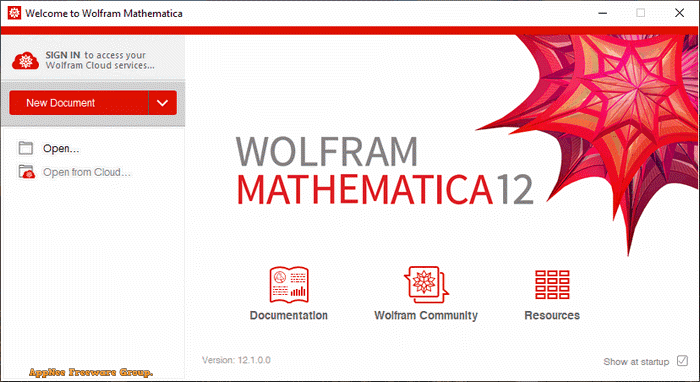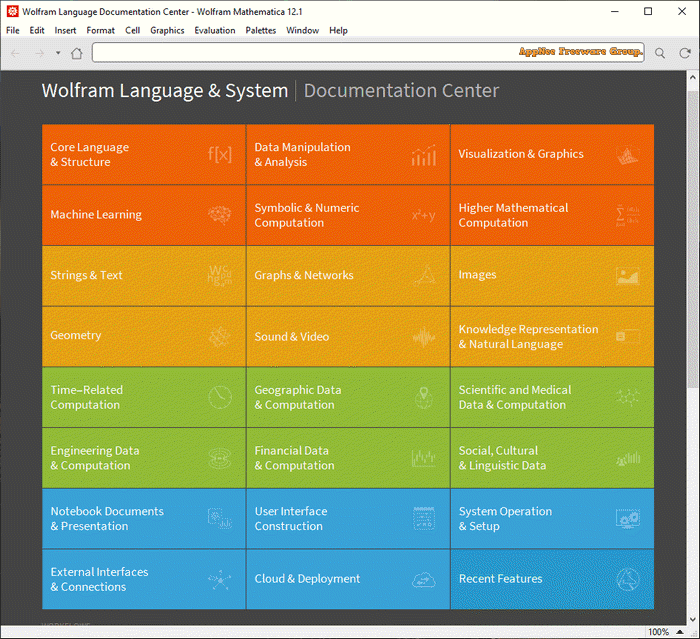| Ⅰ | This article along with all titles and tags are the original content of AppNee. All rights reserved. To repost or reproduce, you must add an explicit footnote along with the URL to this article! |
| Ⅱ | Any manual or automated whole-website collecting/crawling behaviors are strictly prohibited. |
| Ⅲ | Any resources shared on AppNee are limited to personal study and research only, any form of commercial behaviors are strictly prohibited. Otherwise, you may receive a variety of copyright complaints and have to deal with them by yourself. |
| Ⅳ | Before using (especially downloading) any resources shared by AppNee, please first go to read our F.A.Q. page more or less. Otherwise, please bear all the consequences by yourself. |
| This work is licensed under a Creative Commons Attribution-NonCommercial-ShareAlike 4.0 International License. |

Wolfram Mathematica is one of the most powerful and popular general computing systems in the world, as well as one of the most widely used mathematical software programs. Wolfram Mathematica, together with MATLAB and Maple, are called the top three mathematical applications. Since its first release in 1988, it has had a profound impact on how computers are used in technology and many other areas, performing well in almost every computing field, including network, graphics, geometry, data science, data visualization, machine learning, etc.
As a scientific computing software with simple operation and specially designed for Wolfram Language, Wolfram Mathematica employs unprecedented advanced algorithms, provides a singly integrated and continuously extensible system, covers the widest and deepest technical computing functions, comes with more than one hundred and fifty thousand examples, and can be used to perform mathematical calculation, visualization analysis, data analysis, image calculation, interactive computing, geometric calculation, and so on.
In addition to the amazing computing power, the Wolfram Knowledgebase behind Mathematica has the world’s largest information database, which covers a lot of ground: from universes and galaxies, to genomes and quarks, to blockchain and linguistics, covering astronomy and geography, culture and land, nature and science, society and education, economics and finance, literature and art, film and television,… it even includes a complete set of data of Pokémon! No matter what industry or profession you work in, you can find functions that suit you well.
Based on more than 30 years of world-class algorithms and software development, Wolfram Mathematica has made major breakthroughs in expanding its application scope and applicability, and redefined our understanding of computational methods. For a long time, the ubiquity of its core design has made the covered areas grow continuously: from a system primarily used for mathematical and technical calculations to a major force in many computing fields.

// Key Features //
- Libraries of mathematical elementary functions and special functions including Number theory function and combinatoric functions
- Support for complex number, arbitrary precision arithmetic, interval arithmetic, numbers with uncertaintycensored data, temporal data, time series, and unit based data, and symbolic computation
- Matrix and data manipulation tools including support for sparse arrays and associative arrays
- 2D and 3D data, function and geo visualization and animation tools
- Solvers for systems of equations, diophantine equations, ordinary differential equations (ODEs), non-linear partial differential equations (PDEs), differential algebraic equations (DAEs), delay differential equations (DDEs), stochastic differential equations(SDEs), and recurrence relations
- Finite element analysis including 2D and 3D adaptive mesh generation
- Numeric and symbolic tools for discrete and continuous calculus including continuous and discrete integral transforms
- Constrained and unconstrained local and global optimization
- Multivariate statistics libraries including fitting, hypothesis testing, and probability and expectation calculations on over 160 distributions.
- Calculations and simulations on random processes and queues
- Supervised and unsupervised machine learning tools for data, images and sounds including artificial neural networks
- Tools for text mining including regular expressions, semantic analysis, sentiment analysis and fact extraction
- Data mining tools such as cluster analysis, sequence alignment and pattern matching
- Computational geometry in 2D, 3D and higher dimensions and Euclid-style 2D geometry
- Libraries for signal processing including waveletanalysis on sounds, images and data
- Audio processing filters and measures including audio recognition
- Tools for 2D and 3D image processing and morphological image processing including image recognition
- Tools for visualizing and analysing directed and undirected graphs
- Tools for cryptography including symmetric and asymmetric keys, hashing and elliptic curve cryptography
- Tools for financial calculations including bonds, annuities, derivatives, options etc.
- Group theory and symbolic tensor functions
- Tools for Automated theorem proving
- Linear and non-linear control system libraries
- Microcontroller kit for giving symbolic specifications from which it automatically generates and deploys code to run autonomously in microcontrollers.
- Tools for computational chemistry including bond length and angle calculations and databases of chemical properties
- Programming language supporting procedural, functional, object-oriented constructs and parallel programming
- Toolkit for adding user interfaces to calculations and applications
- Tools for creating and deploying cloud based computational applications and services
- Tools to connect to dynamic-link library (DLL), Java, .NET, C++, Fortran, CUDA, OpenCL, and Hypertext Transfer Protocol (HTTP) based systems
- Using both “free-form linguistic input” (a natural language user interface) and Wolfram Language in notebook when connected to the Internet
// System Requirements //
- Microsoft Visual C++ 2015-2022 Redistributable Packages
// Edition Statement //
AppNee provides the Wolfram Mathematica Edition multilingual full installers and all versions universal key generators for Windows 32-bit and 64-bit, Mac and Linux.
// Installation Notes //
for v14.2 on Windows:
- Install Wolfram Mathematica
- Use the keygen to generate a license for Wolfram Mathematica using the Activate offline option
- Done
for v11.3+ on Windows/Mac/Linux:
- Download and install the latest version of Wolfram Mathematica from official site (registration and login required)
- Run program, and choose ‘Other ways to activate‘ -> ‘Manual activation‘
- Use the online/offline key generator to generate the “Activation Key” and “Password” with your “MathID“
- Done
*** Block this program with your firewall.
// Warning //
The keygen might be reported as Win32:Malware-gen threat with high risk. Use VirusTotal to make a full, authoritative scan, and decide to use it or not by yourself.
*** Please remember: antivirus software is not always right, just be careful and use it at your own risk.
// Related Links //
- Wolfram Language Documentation
- The Wolfram Language: Fast Introduction for Programmers
- Mathematica & Wolfram Language: Fast Introduction for Math Students
- Wolfram Video Gallery
- Wolfram Mathematica 12 Key Generator Online
// Download URLs //
| Version | Download | Size |
| Latest |  |
n/a |
| Universal Key Keygens | ||
| v11.3+ Offline, v12.0+ Online |  |
1.52 KB |
| v13.0+ |  |
25.8 KB |
| v14.2 (for Win) |  |
275 KB |
| v14.1 (for Mac) |  |
44.8 KB |
(Homepage)
| If some download link is missing, and you do need it, just please send an email (along with post link and missing link) to remind us to reupload the missing file for you. And, give us some time to respond. | |
| If there is a password for an archive, it should be "appnee.com". | |
| Most of the reserved downloads (including the 32-bit version) can be requested to reupload via email. |